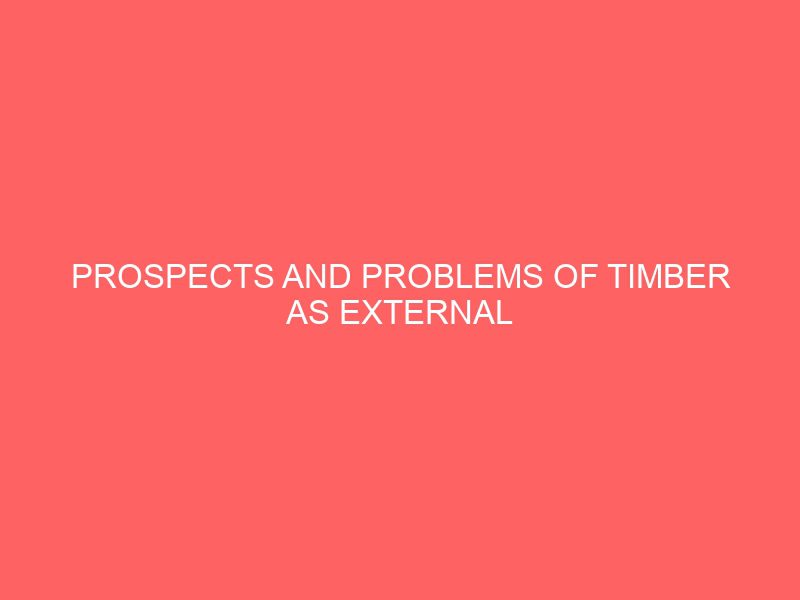Description
CHAPTER ONE
- INTRODUCTION
This project is on Prospects and problems of timber as external material in building production in hot climate region. Timber as external material in building production simply means using timber on the external part of the building such as timber work covering, timber external walls, and timber external windows, doors and frames.
Timber use practices in building production industry is endowed with a variety of tree species in her nature forests and in recent years there has been an increase in the establishment of exotic trees species such as pine and eucalyptus on plantations. Despite the abundance of wood resources, wood has been under utilized with a view that it is material to be avoided due to its perceived unreliability, variability and unknown properties.
Generally, timber research has been academic and has concentrated on a few tree species, resources have not explored the key indicators of wood strength such as bending stiffness and bending strength, they have concentrated on density which has been reported as poor surrogate strength. This is purely the reason timber users cannot accept lesser-known timber. Limited studies have been done to predict the allowance load from bad deflection relationship. This is probably the reason timber users prefer timber with proven truck record, a practice which unfortunately exerts pressure on well-known timber species leading to their building environment coupled with population growth and dwindling wood resources globally necessitates research into optional use of multiple trees species with quality control procedures.
The aim of the study was to examine timber use practices with emphasis on analyzing weakness and strength in the application of wood as an external material in building.
Timber is a cellular material consisting of minute cell called fibre or trenched which have inter-communicating pits or values that allow water and solutions to be conducted through out the structure.
The word timber described wood, which has been cut for use in building. Timber has many advantages as a building material. It is high weight material that is easy to cut, shape and join by relatively cheap and simple hand or power operated tools in the production of timber. Timber is used all parts of building such as farm work, doors and windows, frames, timber, wall plates, floors and also in roof carcass. Timber is a very important material in building production which helps to facilitate building construction. As a structural material it has favourable weight to lost of elasticity relations and coefficients of thermal expansion, values density and specific heat with sensible selection, fabrication and fixing and adequate impregnation or protection. It is a reasonable durable material in relation to the life of most building, wood burn at temperature of about 3500 and chairs, the chaired outer face of the wood protecting the unborn inner wood for period adequate for escape during fire in most building.
Timber is the greatest renewable resources in the building material field. As a building material, it has inherent characteristics which determine its application in construction with a recent better understanding of timber coupled with availability of sound structural design of timber structures and development of economical processing and presentation process, greater or more efficient use in building made of timber in construction.
Generally, timber offers numerous advantages in construction application like beauty, workability, low cost per kg, high strength to weight ration, good electricity installation and low temperatures.
- BACKGROUND OF THE STUDY
Timber research explored the use of timber in building construction industry as one of the most important material in construction. Timber has been used in building in most parts of the world for thousands of years it is natural, renewable and easy to use material. Timber is only building material that properly used positively benefits the plants and our relationship to it. Wood as a building material has the further advantages of being low in the consumption of energy needed in its processing, and hence in its overall impact on the biosphere. The conversion of a tree into klin 5.3 mega joules a kilo, but 35mj/kg are needed to produce a kilo of steel and a staging 145 for aluminum. Timber is the only building material that has empathy i.e. quantities. We identify with wood from the cradle to the coffin it is the only really sustainably building material. It is the one which properly manage and abundantly used, can actually improve the quality of life in the planet because of the ability to look up carbon.
Timber is one of the natural building materials. This has a lot of advantages; generally, timber is not toxic, does not leak, chemical vapour into the building and is safe to handle and touch. It also means that as timber ages it does so naturally and doesn’t breakdown into environmentally damaging materials.
- STATEMENT OF THE PROBLEMS
With my observation and research in building material, I observed that timber as a building material is at low cost. This is to say that timber is the cheaper material in building production, due to high cost of certain materials like aggregates, sand, cement and roofing sheets.
Cost comparisons are difficult to make between timber frame and other construction materials. Actual constructions costs are probably a few percentage points higher for a typical timber frame over brick and block, architects and builders less experienced in timber frame construction tend to increase their prices to compensate for the extra time needed to ensure that the design is correct. This project is a comprehensive study of timber to ascertain the suitability of timber and usefulness as a building material.
Generally, despite the numerous contributions of timber to the construction companies, there is still lot of problems associated with the use of timber in construction. Some of these problems are lack of knowledge in timber treatment methods, non-availability of standard timber connector. Cost effectiveness in the usage of timber, non conformity of timber available in market and many other problems associated with the use of timber as an external material in building production in hot climate.
- AIM AND OBJECTIVES OF THE STUDY
Aim:
The main aim of this study is to assess the problems and prospects of timber as an external material in building production in hot climate.
Objectives:
The following are the objectives of the study:
- To determine the various problems and prospects of timber in building the external parts of the building.
- To determine the functions of timber in building production.
- To evaluate the quality of wood used by the contractors as external material building production.
- To determine the factors militating against effective use of timber as external material in building production.
- To suggest the best ways of minimizing the problems associated with the use of timber in building production.
- To regain the need and value of timber as a building material.
- To achieve the natural quantity of timber as a building material i.e. aesthetics.
- SIGNIFICANCE OF THE STUDY
This research work will benefit so many people, the people who will benefit from this work are:
To serve as source of information to building clients, building, designers, students and several others.
The contractors will benefits immensely from this from this work, as the work will expose them to the problems and prospects of timber as an external material in building production in hot climate.
The study would be significant to students who might wish to use it as a basis for further research; it will serve as a board from which further research might take off. The data already gathered and documented in this project will serve as a source of information to students as well serve a reference material in their class room work.
The work will equally be of great importance to individual citizens of the country who would like to know more about the problem and prospects of timber as an external material in building production in hot climate.
- RESEARCH QUESTIONS
For the purpose of this research work, the following research questions were formulated:
- What are the various problems and prospects of timber in building?
- What are the functions of timber in building production?
- What is the main aim and objectives of using timber as a building material?
- Are there ways of preserving timber from insert and fungal attack?
- What are the types of preservatives?
- What is the method of preservation/application?
- SCOPE OF THE STUDY
This research project will be focused on the problems and prospects of timber as an external material in building production in hot climate. Therefore the researcher will be limiting himself to projects in Nigeria only.
- LIMITATION OF THE STUDY
Limitation in the cause of this research study on inadequate found to effectively carryout a through and comprehensive study of the topic.
Time constraint also hamphered the effective study of the topic. Scarcity of new and current books dealing wholly of timber as our libraries are stocked without edition that does not incorporate new idea and finding some of these books just make passing references to timber without in dept discussion on them.
Inadequate data base compelled by professionals in wood technology in Nigerian timber relates information can be reliable sourced.
- DEFINITION OF TERMS
For easy understanding of the research work, the researcher has carefully defined the terminologies used in the research project. These are as follows:
- CONSTUCTION: This is the building or creating of something.
- ASSESSMENT: This refers to the consideration and judgment of someone or something.
- TIMBER: Trees that is grown to be used in building or for marketing things.
- LUMBER: Pieces of furniture, and other large objects that you do not use anymore.
- CONVERSION: Is the term to the sawing up of the log into timber of marketable size, before the seasoning process.
- SEASONING: This is the removal of surplus moisture from the timber.
- WOOD PRESERVATION: Means the treating of wood with solution which makes it poisonous to insects and fungi.
- SAPWOOD CELLS: Are the growing of cells and have thin cellulose walls.
- SOFTWOOD: It is standard wood used for building construction, fairly strong, easily worked.
- HARDWOOD: Very strong, tough, hard and decorative easily to work with sharp tools.








Reviews
There are no reviews yet.